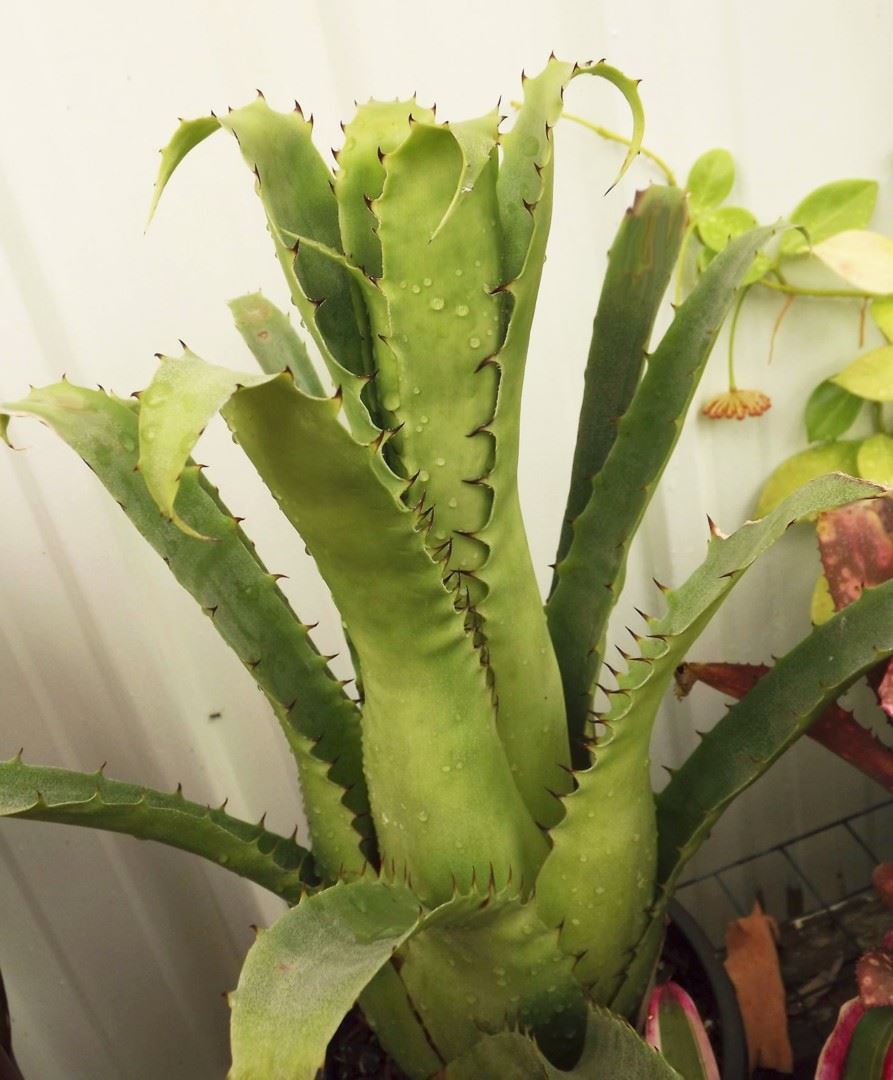


Species nova a Hohenbergia vestita L.B. Sm., cui proxima, sed laminis foliorum marginibus spinis prominentibus, distincte longioribus et retrorsis, bracteis scapalibus internodia aequantibus vel brevioribus et ramis secundariis brevioribus differt; a H. estevesii E. Pereira & Mountinho, cui affinis, sed ramis primariis basalibus sessilibus ver fere, ramis secundariis brevioribus, floribus paucis, sepalis longioribus muticisque, antheris subduplo brevioribus et ovulis obtuse apiculatis differt.
Plant saxicolous, flowering ca. 90 cm tall.
Leaves ca. 16 in number, thick-coriaceous, with the sheaths forming at the base a subtubular to narrowly ellipsoid bottle-like rosette;
Sheaths broadly elliptic-ovate, 19-25 X 12-13 cm, sub-densely to densely brown-lepidote on both sides, castaneous toward the base;
blades sublinear, not narrowed at the base, 18-40 X 3-5 cm, greenish to dark reddish-purple, abaxially subdensely to densely white-lepidote with the trichomes arranged in rows along the intercostal area, distinctly nerved, adaxially densely white-lepidote, apex acuminate and terminating in a narrowly triangular pungent spine ca. 1 cm long, the outer leaves reduced in size and reflexed, the inner ones suberect, margins subdensely to laxly spinose, spines triangular, prevailingly retrorsely uncinate, blackish toward the apex, 4-9 x 4-6 mm (including the apical ones), l0-40 mm apart.
Scape erect, stout, ca. 65 cm long, 0.7-0.8 cm in diameter, dark reddish-purple, densely white lanate;
scape bracts lanceolate, acuminate, 8-10 X 1.8-2 cm, pale colored, papyraceous, nerved, entire, erect, shorter to equaling the internodes, not completely covering the scape, densely white-lepidote with long fimbriate trichomes.
Inflorescence narrowly paniculate, subcylindrical, tripinnate, ca. 24 cm long, ca. 8 cm in diameter at the base, erect, rachis 0.6-0.7 cm in diameter, densely white-lanate, dark reddish-purple;
primary bracts resembling the upper scape-bracts, narrowly sublinear-lanceolate, acuminate, entire, pale rose but soon stramineous, sparsely white-sublanate, spreading, equaling (the upper ones) to exceeding (the remaining ones) the branches, 4-8.5 X 0.8-1.5 cm;
primary branches spreading or nearly so, 3-4.5 cm long at early anthesis, sessile or nearly so, the basal to median ones sparsely arranged, bearing at the base 1 to 2 sessile, densely aggregated secondary branches, the apical ones densely arranged and resembling the secondary branches;
secondary bracts resembling the floral bracts but larger, with a broadly ovate to suborbicular base, 13 X 13-15 mm, and a long spinescent apex 8-10 mm long, shorter than the branches, pale rose, finely nerved, entire, white-lanate, ecarinate:
secondary branches spreading or nearly so, sessile, ellipsoid-ovate (in early state) to subcylindrical, terete, acute, 2-3.5 X 1.3-1.5 cm, bearing 8 to 12 flowers;
floral bracts subtriangular-orbicular, suberect toward the apex, exceeding the sepals, l4-17 X 10-11 mm (including the spinescent apex), thinly coriaceus, rose, subdensely white-lanate, distinctly nerved, entire, ecarinate, apex acute and long mucronate-spinescent, slightly pungent, mucro 5-6 mm long.
Flowers 17-18 mm long, sessile, densely and polystichously arranged, suberect, odorless;
sepals strongly asymmetrical with a rounded wing much exceeding the midnerve, ca. 7 .5 X 4 mm (including the extended wing), without any noticeable mucro, subfree, densely white-lanate, entire, green, ecarinate:
Petals subspatulate-lanceolate, apex subacute to narrowly subobtuse, ca. 13.5 X 3.5 mm, free, lilac toward the apex, suberect at anthesis, bearing at the base 2 narrowly obovate appendages, ca. 5 X 1 mm, irregularly long laciniate at the apex;
stamens included;
filaments not at all dilated, the antepetalous ones adnate to the petals for ca. 3 mm, the antesepalous ones free;
anthers sublinear, ca. 3.5 mm long, base sagittate, apex caudate, fixed slightly below the middle;
pollen subglobose, biporate, psillate;
ovary broadly obovate, ca. 3.5 mm long, ca. 5 mm wide at the apex, densely white-lanate, green, subtrigonous; placentation apical; ovules obtusely apiculate; epigynous tube inconspicuous; stigma conduplicate-spiral, ellipsoid, white, exceeding the anthers.
Fruits unknown.
Comments. Hohenbergia magnispina is closely related to H. vestita, differing from it by its leaf blades with prominently developed marginal spines (4-9 mm long vs. 3-5 mm), which are retrorsely curved (vs. prevailingly antorsely curved), scape bracts equaling to shorter than the internodes (vs. distinctly exceeding the internodes), and by the secondary branches shorter (2-3.5 cm long vs. ca. 5 cm). On the other hand, this new species shares morphological characteristics with H. estevesii, being distinguished by the basal primary branches sessile or nearly so (vs. bearing stipes 1-2 cm long), shorter secondary branches (2-3.5 cm long vs. 5-7 cm) bearing fewer flowers (8 to 12 in number vs. 25 to 35), longer sepals (ca. 7.5 mm long vs. ca. 5 mm), without any noticeable mucro (vs. minutely mucronulate), shorter anthers (ca. 3.5 mm long vs. ca. 6 mm) and by the obtusely apiculate ovules (vs. caudate).
This new species was found forming medium sized saxicolous groups of plants in the "Campos Rupestres" vegetation or grasslands on rocky soils that overlie quartzite and sandstone outcrops that form the high-altitude landscape of the Serra do Espinhaco range in Bahia.
The difficulty in establishing morphological differences of regional Hohenbergia species typical of that environment is due to the convergence of shape and structure of leaves and leaf-rosette caused by the combination of rupicolous or saxicolous habit, oligotrophic conditions, similar sun exposure and water stress.
Therefore, understanding the subtle set of morphological features that distinguish these species appears to be important in establishing the identity of the taxa involved.